Health
Canadian wildfire smoke disrupting air quality for millions of Americans: ‘Can travel deep into the lungs’
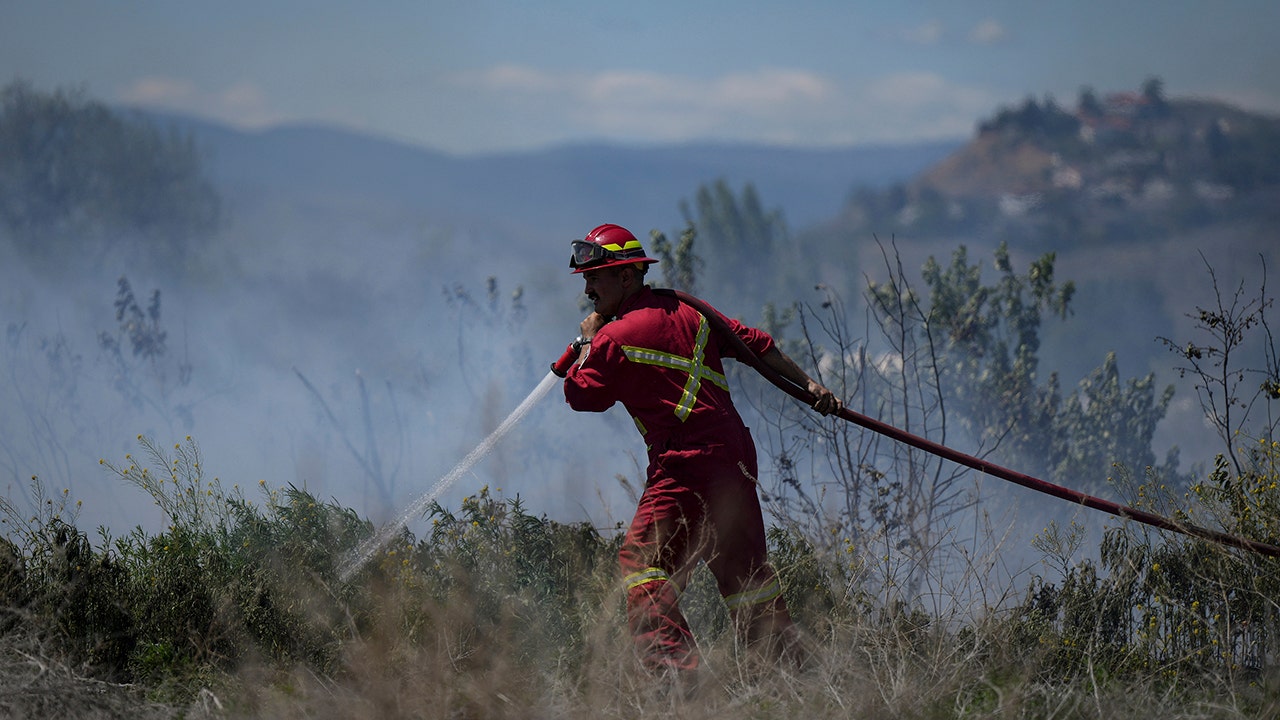
The air quality in the New England states may be unhealthy for millions of Americans right now — especially for those with underlying medical conditions — due to a surge in Canadian wildfires in Quebec and Northern Ontario, according to a recent Environmental Protection Agency (EPA) press release.
“Areas predicted to exceed the federal air quality standard for 24-hour particle pollution level concentrations on June 6 are: Connecticut, Massachusetts, New Hampshire (central, south and western parts of the state), Rhode Island, and Vermont,” the release said.
Satellite images show toxic smoke drifting near the surface of the air from Chicago and Indianapolis to Cincinnati and Wisconsin — suggesting people were breathing in the harmful air from Wisconsin to West Virginia on Sunday, per recent reports.
NOVA SCOTIA WILDFIRE SENDS EAST COAST AIR QUALITY PLUMMETING
And on Tuesday, people in the Northeast, including in New York and the New York City area, were breathing in “unhealthy” air as the region was blanketed in smoke from the Canadian wildfires, according to numerous reports — prompting air quality alerts for the Big Apple and much of the Northeast, according to Fox Weather.
Local officials have advised New Yorkers to limit any strenuous outdoor activity and urged those who have trouble breathing to stay inside.
A firefighter directs water on a grass fire on an acreage behind a residential property in Kamloops, British Columbia, on Monday, June 5, 2023. No structures were damaged, but firefighters had to deal with extremely windy conditions while putting out the blaze. (Darryl Dyck/The Canadian Press via AP)
New England smoke may “linger” over the next few days — but the locations could change, so the EPA recommended that people stay in touch with the EPA New England’s Air Quality Index (AQI) for the most current air quality conditions.
“Wildfires increase air pollution in surrounding areas and can affect regional air quality.”
“Larger and more intense wildfires are creating the potential for greater smoke production and chronic exposures in the U.S., particularly in the West,” the EPA told Fox News Digital.
“Wildfires increase air pollution in surrounding areas and can affect regional air quality.”
RAIN BRINGS HOPE IN BATTLING WILDFIRE IN NOVA SCOTIA AS EVACUATIONS CONTINUE
A previous 2016 study discovered that people who lived in New England over age 65 had a higher risk of premature death from particle pollution.
Fox News Digital interviewed a lung expert about the issue — and the EPA to explain how wildfire smoke is harmful to our health and give some helpful tips to stay safe when around it.
‘So dangerous it can shorten your life’
Particle pollution is a mixture of very small solid and liquid particles in the air that people breathe in every day, according to the American Lung Association.
“It is so dangerous that it can shorten your life,” the lung association noted on its website.
“Wildfire smoke produces very small particulate matter (PM) — 2.5 microns and smaller, that can travel deep into the lungs,” said Dr. Baljinder S. Sidhu.
Previous research, which examined air quality in 545 counties in the U.S. between 2000 and 2007 found that people — especially women and people who lived in urban and densely populated areas — increased their life expectancy by approximately four months on average due to cleaner air.
WILDFIRES MAY THREATEN INPATIENT HEALTH CARE FACILITIES IN MANY CALIFORNIA COUNTIES, STUDY SAYS
These particles are often too small to actually see, but the air becomes opaque when levels are high.
Scientists classify the particles as coarse, fine and ultrafine, depending on their size.
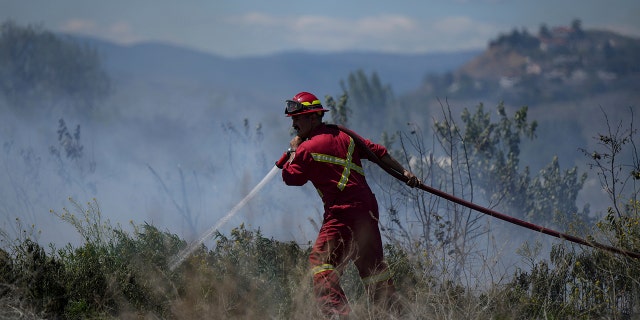
A firefighter is shown directing water on a grass fire on an acreage behind a residential property in Kamloops, British Columbia, on Monday, June 5, 2023. (Darryl Dyck/The Canadian Press via AP)
Coarse particles are between 2.5 microns and 10 microns in diameter, fine particles are 2.5 microns in diameter or smaller and ultrafine particles are smaller than 0.1 micron in diameter.
“Wildfire smoke produces very small particulate matter (PM) — 2.5 microns and smaller, that can travel deep into the lungs,” said Dr. Baljinder S. Sidhu, a pulmonologist and sleep specialist who is the co-owner of Pacific Coast Critical Care Group in Southern California.
“Children, pregnant women, and the elderly are especially vulnerable to smoke exposure.”
Recent research found that fine particles specifically from wildfire smoke may be more toxic to people, up to 10 times more harmful on human health than fine particles from other sources.
What are the effects of smoke?
“The effects of smoke from wildfires can range from eye and respiratory tract irritation to more serious disorders, including reduced lung function, bronchitis, exacerbation of asthma and heart failure, and premature death,” the EPA said.
“Children, pregnant women, and the elderly are especially vulnerable to smoke exposure,” the agency added.
“Emissions from wildfires are known to cause increased visits to hospitals and clinics by those exposed to smoke.”
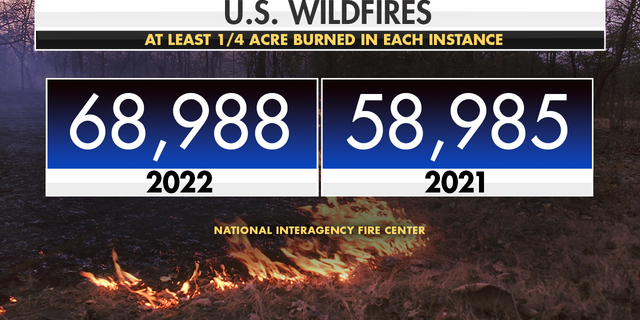
There were over 10,000 more wildfires last year compared to 2021. (Fox News)
The body’s natural defenses are able to cough or sneeze out the larger coarse particles, but they are not able to expel the smaller fine or ultra-fine particles, according to the American Lung Association’s website.
Some of the particles get “trapped” in the lung, but some are so small that are able to pass through into the bloodstream, the association added.
Regardless of the size of the particles, any size of the particles can all be harmful to your health, the American Lung Association added.
“We also encourage you to reduce your exposure outdoors during smoke events to reduce how much smoke you inhale,” the EPA said. “Limit your outdoor exercise when it is smoky, or choose lower-intensity activities to reduce your smoke exposure,” the agency added.
During days when the air is full of wildfire smoke, Dr. Sidhu recommended that people stay indoors and keep windows closed.
“When indoors, take steps to keep your indoor air cool and clean.”
The air quality can rapidly change due to smoke, the EPA noted.
CLICK HERE TO SIGN UP FOR OUR HEALTH NEWSLETTER
“The Air Quality Index is a total measure that includes PM, ozone, NO2, CO and sulfur dioxide,” Sidhu added.
“It has been well studied that levels over 100 can lead to increased exacerbations of asthma, COPD and other respiratory ailments in all ages, but particularly children and the elderly.”
The EPA encouraged people to stay up-to-date on current air quality and forecasts.
During days when the air is full of wildfire smoke, Dr. Sidhu recommended that people stay indoors and keep windows closed. “Using a N95 mask can filter 95% of PM 0.3 [micron size] and larger,” he said.
If driving, adjust the air conditioner controls so that the air is being recirculated, he said.
He also advised that people make sure their vehicle’s cabin air filter is in good working order and suggests considering upgrading to a HEPA filter.

Health
Introducing Our Product Reviews Team, and How We Review | Woman's World

Sign Up
Create a free account to access exclusive content, play games, solve puzzles, test your pop-culture knowledge and receive special offers.
Already have an account? Login
Forgot your password?
Get back to the Sign In
Use left and right arrow keys to navigate between menu items.
Use escape to exit the menu.
Health
What You Should Know About the Military Diet: Experts Weigh In | Woman's World

Sign Up
Create a free account to access exclusive content, play games, solve puzzles, test your pop-culture knowledge and receive special offers.
Already have an account? Login
Forgot your password?
Get back to the Sign In
Use left and right arrow keys to navigate between menu items.
Use escape to exit the menu.
Health
Could your car make you sick? Study highlights potentially cancerous toxins in vehicles
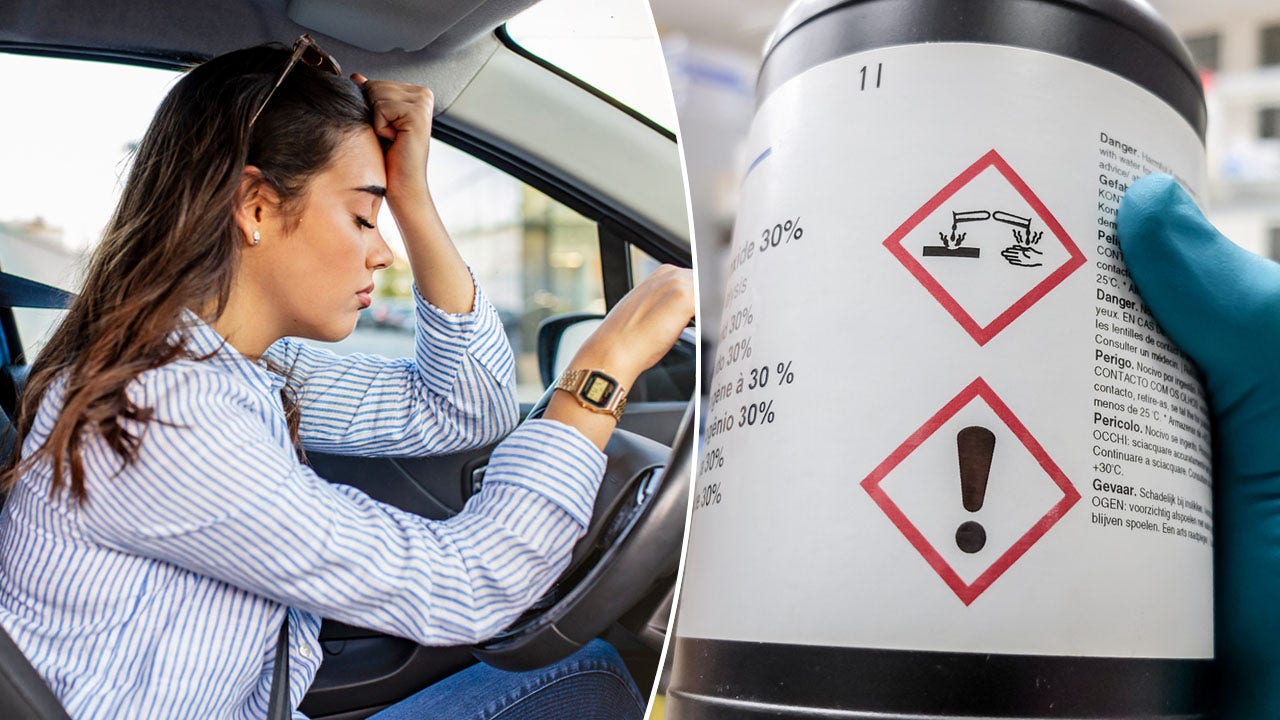
Americans may be breathing in cancer-causing chemicals while driving, recent research suggests.
A study published in the journal Environmental Science & Technology has sparked discussions about the potentially harmful toxins that could be lurking in the cabins of vehicles.
“Certainly the indoor air quality can cause health symptoms,” Dr. Ken Speath, M.D., the division chief and medical director for occupational and environmental medicine at Northwell Health on Long Island, New York, told Fox News Digital.
‘FOREVER CHEMICALS’ FOUND IN US DRINKING WATER, MAP SHOWS ‘HOT SPOTS’ OF HIGHEST LEVELS
It is important to be mindful of what you’re breathing in at home, at the office, at school and even in cars, according to Speath, who was not involved in the study.
“There can be situations where levels of harmful chemicals get high enough to potentially cause health harms,” he said.
Americans may be breathing in cancer-causing chemicals while they are driving, recent research suggests. A study published in the journal Environmental Science & Technology has sparked many discussions. (iStock)
“A car is a closed small space — so whatever is in the air is certainly going to be breathed in.”
Research reveals ‘harmful chemicals’
The peer-reviewed study looked at 101 owned vehicles in the U.S., model year 2015 or newer.
The researchers concluded that harmful flame-retardant chemicals — including those suspected of potentially causing cancer and some neurological issues — may be polluting the air inside vehicles.
DRIVING DANGERS: 9 TOP DISTRACTIONS THAT CONTRIBUTE TO ACCIDENTS, ACCORDING TO EXPERTS
“Flame retardant chemicals, which are intentionally added to vehicle interiors to meet flammability standards, are released into the cabin air from the materials to which they were applied,” lead author Rebecca Hoehn, a scientist at Duke University, told Fox News Digital.
“People in these vehicles may be exposed to these chemicals.”
Seat foam was the only material the researchers measured, Hoehn said, but other interior materials could also contain the chemicals.

The researchers concluded that harmful flame-retardant chemicals — including those suspected of potentially causing cancer and some neurological issues — may be polluting the air inside vehicles. (iStock)
“Considering the average driver spends about an hour in the car every day, this is a significant public health issue,” Hoehn warned.
“It’s particularly concerning for drivers with longer commutes, as well as child passengers, who breathe more air pound for pound than adults.”
The chemicals detected in the car cabins included a flame retardant called tris (1-chloro-isopropyl) phosphate (TCIPP), which is currently being investigated as a potential carcinogen by the U.S. National Toxicology Program.
“Considering the average driver spends about an hour in the car every day, this is a significant public health issue.”
Other flame retardants — tris (1, 3-dichloro-2-propyl) phosphate (TDCIPP) and tris (2-chloroethyl) phosphate (TCEP) — were also detected.
These are “two Californian Proposition 65 carcinogens linked to neurological and reproductive harms,” according to a press release.
Higher concentrations of the flame retardants were found during warmer weather.
“We found that the same cars, sampled in both winter and summer, had higher concentrations of flame retardants in the cabin air during the warm summer months,” Hoehn told Fox News Digital.

Flame retardants are added to vehicles to meet the National Highway Traffic Safety Administration Federal Motor Vehicle Safety Standard, which mandated their use in the 1970s. (iStock)
Flame retardants are added to vehicles to meet the National Highway Traffic Safety Administration Federal Motor Vehicle Safety Standard (FMVSS 302), which mandated their use in the 1970s, the release stated.
Flame retardants have been the “focus of concern for some time,” Speath told Fox News Digital.
More information is needed to determine the health risks these chemicals pose in humans, he said.
THESE MEDICATIONS COULD MAKE DRIVING DANGEROUS, THE FDA WARNS
“A number of these have been demonstrated in studies to have health harms in animals,” he said.
“That doesn’t necessarily mean that would be true for humans, but it raises that possibility, so we need to study these chemicals more in relation to their effects on humans.”

Higher concentrations of the flame retardants were found during warmer weather, the researchers said. (iStock)
Emanuela Taioli, M.D., PhD, the director of the Institute for Translational Epidemiology at Icahn School of Medicine at Mount Sinai in New York City, was also not part of the study, but shared her reactions.
“This is a very relevant finding, since it may prompt changes in cars’ upholstery, as well as in other parts of the car where there is foam,” she told Fox News Digital via email.
“We also want to know more about this finding and monitor whether it is replicated by other investigators.”
Other sources of toxins
Stephen Showalter, a home inspector and indoor environmental air consultant with Showalter Property Consultants in Maryland, said he typically interviews clients about their history of illness, then tests for potential sources of sickness in buildings, cars, RVs and boats.
Mold is a common culprit when it comes to health issues triggered by one’s environment, he said in an interview with Fox News Digital.
TOXIC CHEMICAL POISONING: HAVE YOU BEEN AFFECTED? HOW TO KNOW
Dr. Daniel Johns, a member of the International Society of Environmentally Acquired Illnesses and a chiropractor who practices in Annapolis, Maryland, echoed Showalter’s concerns about mold-related health issues.
Johns also cautioned that cars can be a daily source of mold exposure.
“Any water that leaks from a window, sunroof or convertible can get into the carpet and cause mold growth,” he said during an interview with Fox News Digital.
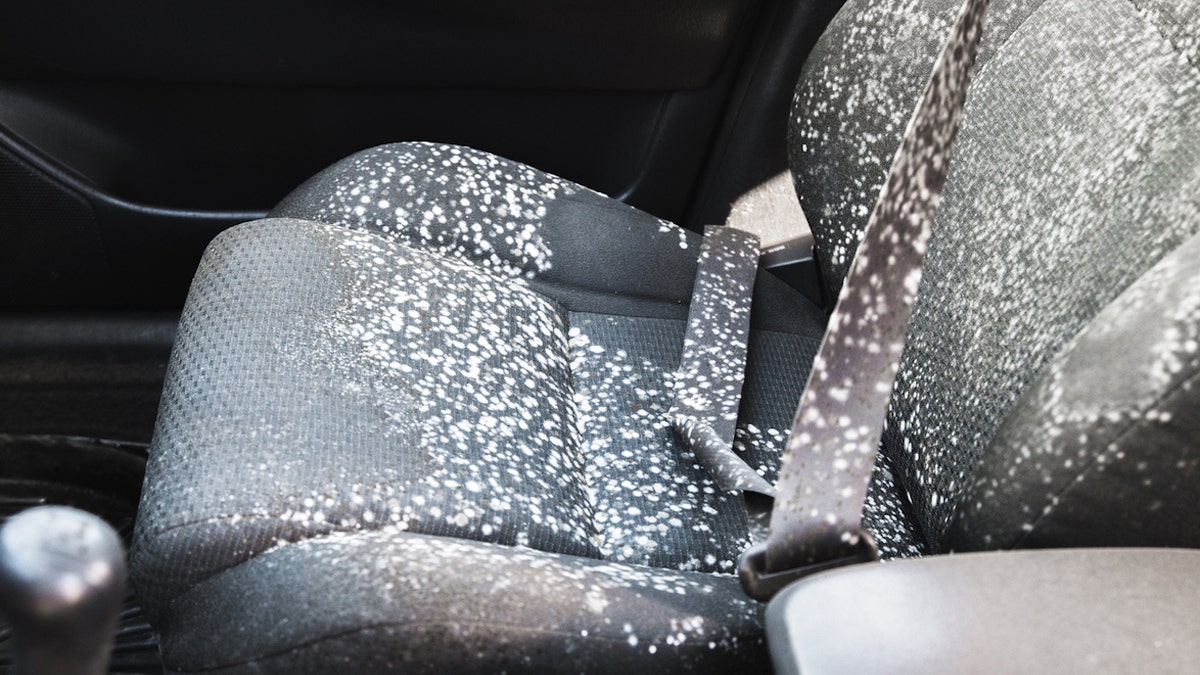
Mold is a common culprit when it comes to health issues triggered by one’s environment, according to an environmental expert. (iStock)
“Mold can start growing on a wet surface within 24 to 48 hours.”
For families with small children, spilled sippy cups could play a role when it comes to mold in cars, Johns warned.
“The water seeps into the upholstery and doesn’t get noticed or properly dried out, and the whole seat can become moldy,” he said.
“Mold can start growing on a wet surface within 24 to 48 hours.”
“Every time you sit on the seat, it releases a mold spore cloud into the car. Once that happens, you can’t clean it away. The upholstery must be removed and replaced.”
The impact of these potentially harmful pollutants can vary from one person to the next, experts told Fox News Digital.

For families with small children, spilled sippy cups could play a role when it comes to mold in cars, an expert warned. (Kids and Car Safety)
People metabolize chemicals and toxins in different ways, according to Taioli.
“Metabolism happens through enzymes that the body produces,” he said.
“Each of us has a different genetic profile that defines our metabolic capacity. As a consequence, the same amount of toxin may be metabolized better/faster by some, and worse/slower by others.”
Tips for ensuring safe interiors
While further research on car-borne chemicals is needed, experts say people can take measures to limit exposure.
“People may be able to reduce their exposure by ventilating their cars,” Hoehn advised.
“For example, rolling down the windows to let out contaminated air, or pulling in fresh air with climate control systems, should reduce concentrations.
“Ultimately, reducing the amount of flame retardants added to vehicles in the first place would provide the greatest reduction in exposure risk.”
Controlling your vehicle’s cabin temperature may also reduce exposure, she added.
“Parking in a garage or shade instead of full sun may reduce the cabin temperature and limit the extent of flame retardant release,” Hoehn said.
The researchers also called for action from regulatory agencies and vehicle manufacturers.
CLICK HERE TO SIGN UP FOR OUR HEALTH NEWSLETTER
“Ultimately, reducing the amount of flame retardants added to vehicles in the first place would provide the greatest reduction in exposure risk,” Hoehn noted.
“If flammability standards for vehicles could be revised to meet fire safety guidelines without the use of added flame retardants, risk of flame retardant exposure from personal vehicles could be greatly reduced.”
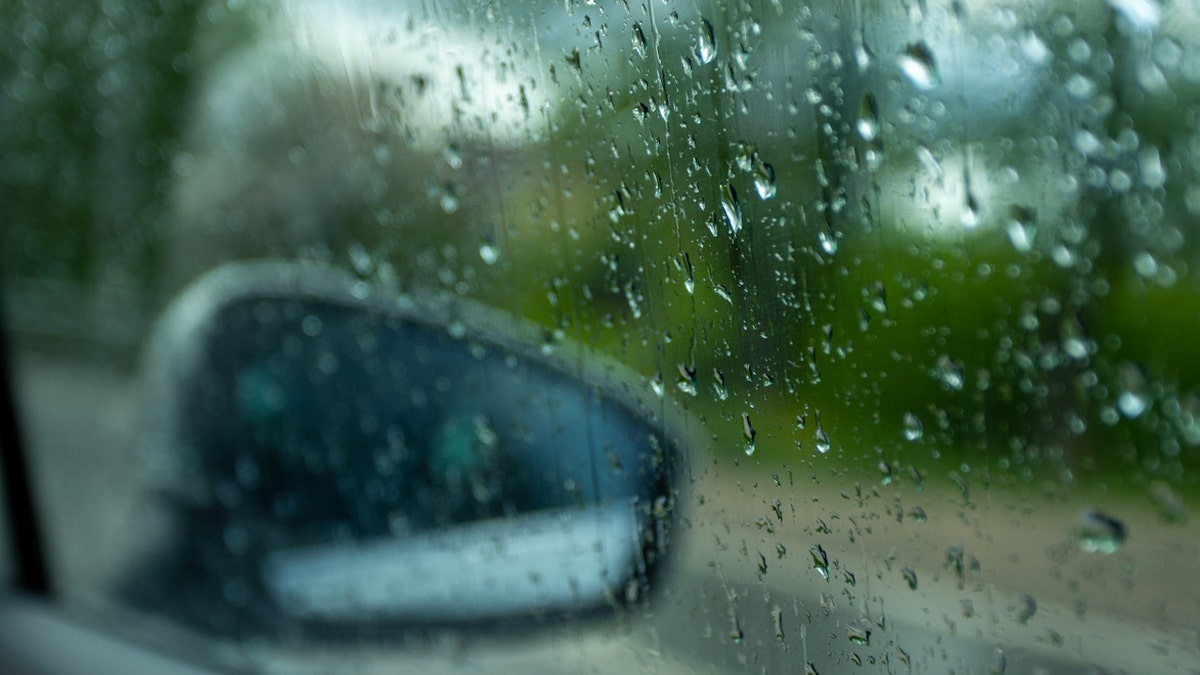
To prevent mold in a vehicle, experts recommend keeping your windows up when it rains or snows to prevent water from permeating the carpet or fabric. (iStock)
Having your car’s air quality and surfaces tested is one way to reduce the risk of exposure to allergens, toxins and chemicals, experts told Fox News Digital.
To prevent mold in a vehicle, Showalter recommends keeping your windows up when it rains or snows to prevent water from permeating the carpet or fabric.
He also cautioned about leaky air conditioners, which can foster mold growth in vehicles, and about leaving wet items in the car.
Lastly, before buying a used car, he said it is important to check the vehicle’s history to make sure it doesn’t have flood damage, which can lead to mold and other issues.
If you think you are experiencing illness due to chemical exposure in your car, home or office, it’s best to see a health care professional to discuss your symptoms.
Fox News Digital reached out to several major car companies for comment.
For more Health articles, visit www.foxnews.com/health.
-

 Finance1 week ago
Finance1 week agoSpring Finance Forum 2024: CRE Financiers Eye Signs of Recovery
-

 World1 week ago
World1 week agoIndia Lok Sabha election 2024 Phase 4: Who votes and what’s at stake?
-

 News1 week ago
News1 week agoThe Major Supreme Court Cases of 2024
-

 Politics1 week ago
Politics1 week agoTales from the trail: The blue states Trump eyes to turn red in November
-

 World1 week ago
World1 week agoBorrell: Spain, Ireland and others could recognise Palestine on 21 May
-

 Politics1 week ago
Politics1 week agoFox News Politics: No calm after the Stormy
-

 World1 week ago
World1 week agoUkraine’s Zelenskyy fires head of state guard over assassination plot
-

 Politics1 week ago
Politics1 week agoUS Border Patrol agents come under fire in 'use of force' while working southern border


















